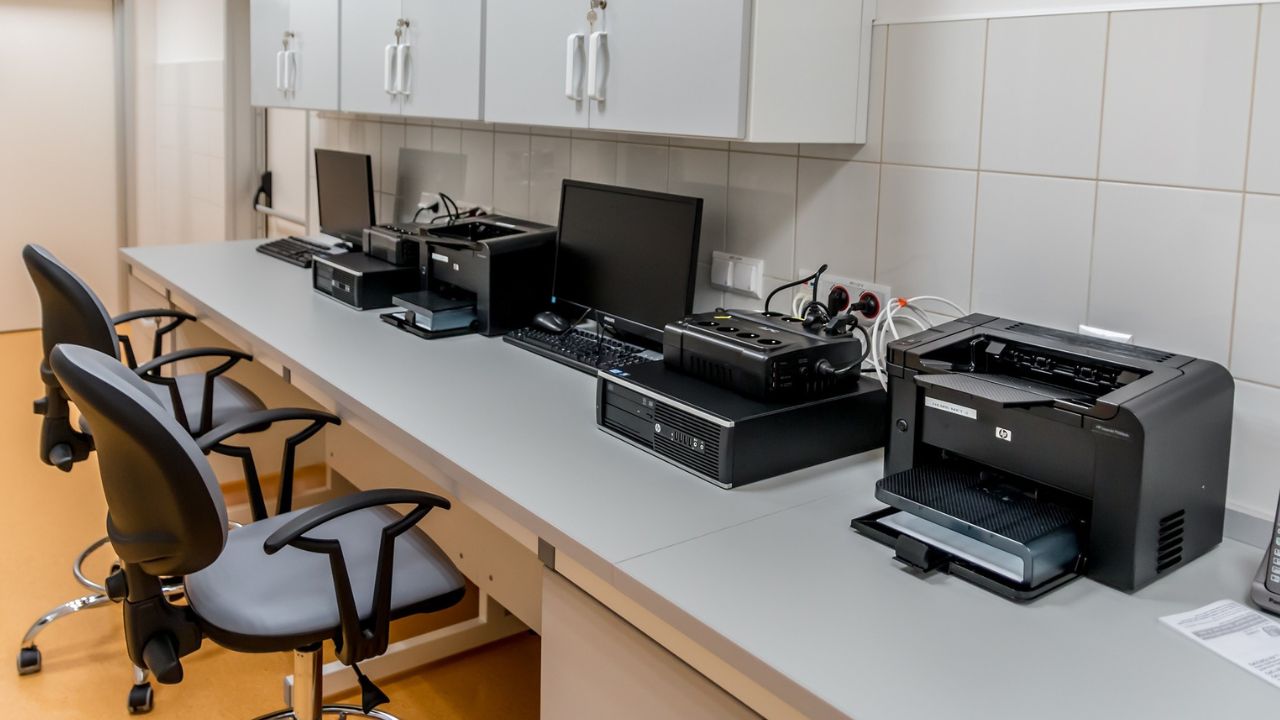Computer Hardware – Definition, Components and Examples

Delve into the intricate world of computer hardware, encompassing the tangible components that power your device.
From the sturdy case to the brainy central processing unit (CPU), the swift random access memory (RAM), and the visual delights of the monitor, every element plays a crucial role.
Please navigate through the essential components, including the mouse, keyboard, storage units, graphics card, sound card, speakers, and the backbone of it all: the motherboard.
What is computer hardware?
Computer hardware refers to the tangible components integral to a computer system’s functionality.
These encompass any physical parts or elements that contribute to its operation. Diverse hardware types exist within a PC, common to both desktop and laptop configurations.
However, variations in size and type occur due to the compact design inherent in laptops.
What is the difference between hardware and software?
Hardware encompasses the tangible elements of your computer, those you can physically interact with. These components are typically assembled inside your computer case and secured with a screwdriver.
In contrast, software refers to the programs installed on your computer, which you cannot touch. These programs consist of sets of instructions that dictate how your PC functions.
What is a motherboard?
The motherboard of your computer serves as the central hub that interconnects all other hardware components, functioning as the mastermind behind power distribution and coordination.
When building or upgrading a PC, it’s crucial to prioritize motherboard compatibility, as it heavily influences the system’s capabilities.
The motherboard dictates the compatibility of various hardware components, including storage devices available in formats such as 2.5-inch SATA SSD or M.2 NVMe SSD.
Additionally, when considering a new motherboard, it’s advisable to assess factors like the number and type of USB ports (USB 2.0, 3.0, 3.1) and the available display ports (HDMI, DVI, RGB), as these can significantly impact your computing experience.
What is a central processing unit (CPU)?
The CPU, or central processing unit, is the core component of your computer, directing its functions akin to the brain.
Its primary role is to process data efficiently. The rate at which it accomplishes this task is referred to as “clock speed,” quantified in gigahertz (GHz).
A CPU boasting a higher GHz rating typically indicates faster performance compared to others within the same brand and generation.
What is random access memory (RAM)?
Computer RAM, or random access memory, collaborates closely with the CPU, storing temporarily generated program data for immediate access. Often referred to as “volatile” memory, RAM clears this data every time your computer restarts.
RAM plays a pivotal role in various tasks, including graphic design image rendering, video or photo editing, and seamless multitasking with multiple open applications or programs.
Given its significance in computer operation, upgrading RAM stands as one of the quickest and most effective solutions for addressing a sluggish computer.
The amount of RAM required varies based on the programs you intend to run. Gamers typically find 8GB sufficient, although higher FPS rates in more demanding games may necessitate additional memory.
Creatives, such as video and graphic designers, often require 16GB or more to handle resource-intensive applications like Adobe® Photoshop or After Effects.
For a comprehensive understanding of how RAM speeds, densities, and generations impact user experience, delve into the evolution of DRAM technology, tracing its progression from early SDRAM to the latest DDR5 model.
What is a power supply unit (PSU)?
The power supply unit (PSU), depicted against a white backdrop, serves a crucial role in the computer ecosystem.
It functions by drawing electricity from an external power source or laptop battery and channels it to the motherboard to energize individual hardware components.
This underscores the importance of selecting a power supply unit with appropriate wattage.
In contemporary computing, a PSU typically needs 500 to 850 watts to adequately sustain the operation of all hardware components.
However, systems utilized for demanding tasks such as graphic design or gaming necessitate more robust components and a higher wattage PSU.
It is advisable to opt for a power supply that offers a margin of additional capacity.
This proactive measure serves to safeguard against system failures and ensures the flexibility to accommodate future upgrades to more potent components.
How do you see what hardware your computer has?
With a deeper comprehension of each component’s significance, you can now verify your hardware specifications through various methods.
Utilize tools such as the Peoplelaptop System Scanner or the Peoplelaptop System Selector, both designed to offer upgrade options compatible with your PC or motherboard.
Alternatively, access your hardware details through system settings or physically inspect the labels on the hardware components themselves.
Computer Hardware Related Post:
What is Computer Hardware?
Why Computer Hardware Is Important
What Is Computer Hardware and Its Components?
What is the Difference Between Hardware and Software
How to Fix Basic RAM Problems
How Long Does RAM Last in a Laptop: RAM Memory Life
A Comprehensive Guide: How to Test Your PC for Failing Hardware
A Comprehensive Guide: How to Test Your PC for Failing Hardware
Which Refresh Rate Should I Choose? – 144Hz vs 240Hz
Signs of a Fading Processor: How to Tell If Your CPU Is Dying
Signs of a Fading Processor: How to Tell If Your CPU Is Dying
RAM Performance – Single Side vs Double Side
CPU Fan Header Vs. System Fan Header: What’s The Difference?
CPU Fan Header Vs. System Fan Header: What’s The Difference?
A Step-by-Step Guide: How to Hardware Reset Your Laptop
Software in the Loop (SIL) Vs. Hardware in the Loop (HIL)
Game On: The Best Wireless Gaming Mouse in the USA
ASUS vs Gigabyte Motherboards: Which is Better?
How to Choose Between GPU and CPU Rendering
Difference Between Supercomputer and Quantum Computer
Difference Between Microprocessor and Microcontroller
How to Transfer OS from HDD to SSD? Beginners’ Guide 2024
How To Learn About Computer Hardware
What Types of Equipment are Used in Computer Hardware Maintenance?
